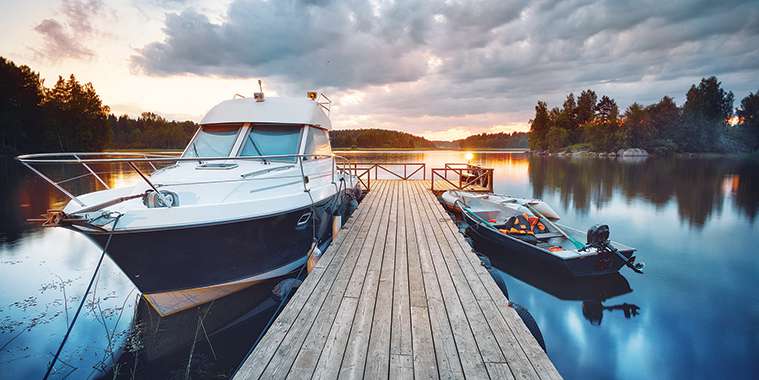Nothing says summer in Canada like cruising across a glass-like lake in the morning. The opening of boating season is right around the corner and May 20-27 is North American Safe Boating Week. It’s easy to lose sight of the risks of boating if you are unprepared, so keep yourself and your family safe by following these top boating safety tips:
Check and maintain your boat
Making necessary repairs early can help you avoid more costly fixes down the line and keep you from getting stranded on the water if your boat dies. At least once a year check your boat from bow to stern. Check the hull for any signs of damage, tune up the engine, and look at the electrical cables, batteries, and fuel lines for signs of damage or leaks. Make repairs using only ignition-protected parts and materials that are suitable for use in marine environments.
You can also request a pleasure craft courtesy check. Transport Canada works with various boating safety organizations to offer free courtesy checks for pleasure craft. A trained boating safety volunteer boards your boat and checks the safety equipment and other requirements, identifies any problems, and discusses boating safety issues with you. Education and prevention are the keys to this program. Since there are never any penalties involved, it’s a great opportunity to learn more about boating safety and make sure that you are ready to take your vessel out on the water.
Know the waterway and check for restrictions
Reefs, stumps, rocks, changing water levels, and sandbars are examples of hazards you need to know about. Carry local marine charts if available or ask someone who knows the area about any hidden dangers. You should also check for any vessel operation restrictions on the waterways where you plan to go boating.
You may have to stop or turn suddenly to avoid a collision, so always operate at a safe speed. Follow all posted speed limits and the universal shoreline speed restriction, which is 10 kilometres per hour within 30 metres of shore on all waters in Ontario, Manitoba, Saskatchewan, Alberta, and the inland waters of British Columbia and Nova Scotia.
Fuel up safely
Boats running out of gas is one of the top reasons boaters call for assistance. This situation is easy to avoid by always checking your fuel levels before leaving the dock. Remember the golden rule: 1/3 to go, 1/3 to return, and 1/3 in reserve.
When fueling, always mop up spills and watch for leaks to avoid fire hazards. Also keep in mind that gas vapours are extremely explosive and are difficult to remove if they accumulate. Always run your blower for at least four minutes before starting your motor.
Staying sober is your responsibility
Boating while drinking or taking drugs can lead to dangerous situations. When boating impaired, you are not just a danger to yourself but to others, too. Mixing alcohol and drugs with boating is far more dangerous than you may realize. Fatigue, sun, wind and the motion of the boat may dull your senses. Alcohol and drugs intensify these effects, leaving you with reduced fine motor skills and impaired judgement.
Impaired driving, whether on land or water, is punishable under the Criminal Code of Canada. Convictions for a first offence can result in: fines, prohibition from operating a boat or motor vehicle, seizure of the boat and possible prison terms. The laws and penalties for when a boater is considered impaired follow provincial and territorial driving laws. Contact your local, provincial or territorial law enforcement authorities for more information.
Safety equipment
Choosing the right life jacket or Personal Floatation Device (PFD) is very important for keeping you and your onboard guests safe. You are required by law to have a lifejacket or PFD on board for each person on a watercraft. This includes human-powered craft likes kayaks or canoes. In almost 90% of fatal boating incidents in Canada, the victims were not wearing flotation devices, or were not wearing them correctly.
There are differences between lifejackets and PFDs. Lifejackets are able to turn you on your back in seconds to keep your face out of the water, even if you’re unconscious, they only come in red, orange or yellow to make you more visible, and offer thermal protection from cold water shock. PFDs come in many types, shapes, colours and sizes. They are less bulky than a lifejacket but offer less flotation, less thermal protection and limited capability to turn you over in the water than a lifejacket. Check out wearalifejacket.com for more information about selecting which type is best for your purposes.
Never underestimate how much protection a flotation device can give you. It’s called lifesaving equipment for a reason. It won’t work if you don’t wear it.
Prepare before you sail
Always take a few minutes to make sure you’re ready to boat safely before you leave. This can prevent problems when you’re out on the water. Complete a departure checklist that includes safety equipment, and don’t forget to check the water and weather conditions to ensure you’re prepared. Weather conditions can change quickly on open water.
Telling a responsible person about your trip plan — also known as a sail or float plan — is also a good idea. Let the person know when you intend to return in case something happens to you. If no one knows that you left, you won’t be missed so a search and rescue team (SAR) won’t be contacted. Locate your nearest volunteer team via the sarvac.ca website.
Learn more about safe boating from the Transport Canada Office of Boating website at tc.gc.ca or for more details on PFDs visit wearalifejacket.com
— News Canada



